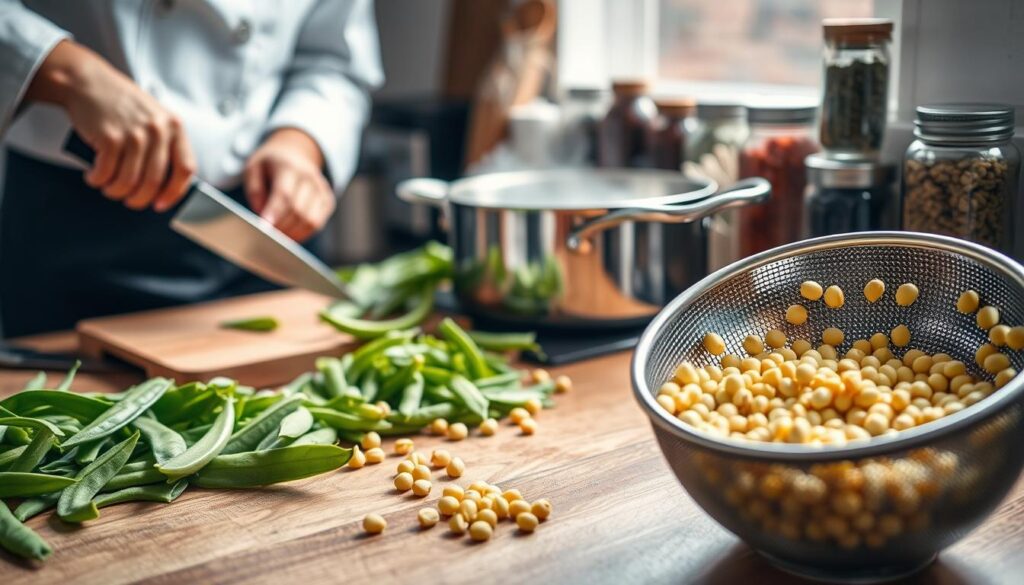Imagine a humble ingredient that slips effortlessly into soups, salads, and casseroles while packing more nutritional power than most trendy superfoods. Meet the unsung hero of your pantry: creamy, versatile, and loaded with benefits you’ve likely overlooked.
Often called butter beans in the South, these pale green gems have been a staple for centuries. They’re sold dried, frozen, or canned – perfect for busy weeknights or meal-prep Sundays. With a texture as smooth as avocado and a flavor that adapts to spices and herbs, they’re anything but boring.
Why does this matter now? As more Americans seek plant-based proteins and fiber-rich foods, these legumes deliver. A single serving offers nearly a third of your daily fiber needs with fewer calories than a medium banana. Plus, they’re budget-friendly – costing less than $2 per pound in most stores.
Key Takeaways
- Discover a protein-rich legume that adapts to countless recipes
- Learn how its fiber content supports digestion and weight goals
- Explore three convenient forms: dried, frozen, and ready-to-use canned
- Uncover heart-healthy minerals hidden in every creamy bite
- Find simple ways to add this underrated ingredient to your weekly menu
Ready to rethink what’s possible with this kitchen chameleon? Let’s dive into its surprising benefits – and how to make it shine in your favorite dishes.
Nutritional Benefits and Health Impact
Behind their mild flavor hides a nutritional profile that supports heart health and steady energy. One cup of cooked legumes delivers 9 grams of fiber and 12 grams of plant-based protein – enough to keep you full while nourishing your body. Let’s unpack how these little wonders work their magic.
More Than Just Fiber and Protein
That same serving provides over half your daily manganese needs. This mineral helps convert food into energy. Copper, another key player, supports immune function and iron absorption. Together, they turn a simple side dish into a metabolic booster.
| Nutrient | Amount per Cup | Daily Value % |
|---|---|---|
| Fiber | 9g | 32% |
| Protein | 12g | 24% |
| Manganese | 1.3mg | 57% |
Your Heart and Blood Sugar’s New Best Friend
Soluble fiber acts like a sponge in your gut, soaking up excess cholesterol before it enters your bloodstream. Studies show eating legumes three times weekly may lower heart disease risk by 22%.
Their low glycemic index makes them ideal for maintaining steady blood sugar levels. Research in the American Journal of Clinical Nutrition found regular consumption cuts diabetes risk by 35% compared to low-legume diets. Now that’s what we call smart eating!
Lima Beans Nutrition: A Closer Look
What makes this legume a nutrient-dense choice for your plate? Let’s explore the science-backed profile that turns simple meals into wellness boosters.

Macronutrients and Micronutrients Breakdown
A single cup (170g) of cooked legumes delivers:
- 209 calories – equivalent to a medium sweet potato
- 12g protein – equal to 2 eggs
- 9g fiber – 32% of your daily needs
But the magic doesn’t stop there. This serving packs 25% of your daily iron needs – crucial for oxygen transport – and 21% of vitamin C, surprising for a non-citrus food. Manganese shines here too, with 57% of your daily requirement supporting bone health and metabolism.
Antioxidants and Their Role in Wellness
These pale-green pearls contain compounds that fight cellular damage. Research shows their antioxidant content rivals blueberries, thanks to:
- Vitamin C neutralizing free radicals
- Manganese activating protective enzymes
- Polyphenols reducing inflammation
“Legume-rich diets correlate with 15% lower oxidative stress markers,” notes a 2022 study in Nutrients journal.
The fiber-protein combo keeps energy stable. One study found participants felt 31% fuller after meals containing these legumes compared to rice-based dishes. Now that’s smart fuel!
Cooking and Preparation Techniques
Transforming dried legumes into creamy delights requires just a few simple steps. Mastering these methods unlocks their full potential while preserving their energy-boosting nutrients like magnesium and manganese. Let’s turn these pantry staples into weeknight superstars.

Soaking, Boiling, and Enhancing Flavor
Start by soaking dried varieties overnight in water. This cuts cooking time by half and reduces compounds that interfere with nutrient absorption. Drain, rinse, then simmer in fresh water with a pinch of salt until tender (about 45-60 minutes).
Boost flavor by swapping water for vegetable or chicken stock. Add garlic, bay leaves, or smoked paprika during boiling. For a butter-like richness without added fat, stir in a tablespoon of olive oil after cooking.
Recipe Ideas for Everyday Meals
Try these easy swaps in your favorite dishes:
- Succotash Salad: Mix one cup cooked legumes with corn, cherry tomatoes, and fresh basil
- Protein-Packed Hummus: Blend with tahini, lemon, and cumin for a twist on classic dip
- Weeknight Stew: Simmer with diced tomatoes, carrots, and thyme for a hearty diet-friendly meal
Their mild taste pairs perfectly with bold flavors like smoked ham or chili flakes. For busy cooks, canned varieties (rinsed well) work in most recipes. Just watch sodium levels to keep dishes low-salt and heart-healthy!
Addressing Potential Downsides and Antinutrients
While packed with benefits, even superfoods have their considerations. Understanding how to handle certain natural compounds ensures you reap all the advantages without drawbacks.

Nature’s Built-In Protections
Raw varieties contain linamarin, a compound that breaks down into cyanide. Proper soaking and boiling neutralize this risk completely. Canned or frozen options eliminate concerns, as they’re pre-cooked during processing.
| Compound | Raw Content | Cooked Content | Risk Level |
|---|---|---|---|
| Linamarin | High | None | Dangerous if raw |
| Phytic Acid | Moderate | Low | Reduces mineral absorption |
| Lectins | Present | Destroyed | Digestive irritation |
Easing Into Fiber-Rich Foods
Some people experience gas when increasing fiber intake quickly. Start with small portions and drink plenty of water. Pairing them with digestive-friendly spices like cumin or ginger helps too.
Research shows gradual introduction reduces discomfort by 68%. The Copper Development Association notes proper preparation preserves this mineral’s value for immune support. Remember – your gut adapts to higher fiber over time!
“Well-cooked legumes pose no health risks and offer substantial disease-fighting benefits,” confirms a 2023 FDA report on plant-based foods.
Commercially sold products meet strict safety standards. By following basic cooking steps, you transform potential concerns into nutritional powerhouses that support diabetes management and heart health.
Integrating Lima Beans into a Balanced Diet

What if your favorite meals could boost your health without extra effort? These creamy legumes blend seamlessly into everyday eating while delivering lasting wellness advantages. Let’s explore smart strategies to make them a delicious staple.
Meal Planning Made Tasty
Start simple: toss cooked legumes into lunch salads or stir them into veggie-packed soups. Their mild flavor absorbs dressings and spices beautifully. For busy evenings, mix canned (rinsed) varieties with quinoa and roasted veggies – dinner ready in 15 minutes!
The fiber-protein combo helps control hunger. Studies show meals featuring these ingredients keep people satisfied 2 hours longer than low-fiber options. Try swapping half the ground beef in tacos with mashed legumes for a weight-friendly twist that still satisfies.
Long-Term Wellness Wins
Regular consumption supports three key health areas:
- Digestive harmony: 9g fiber per cup keeps things moving smoothly
- Energy stability: Slow-release carbs prevent blood sugar spikes
- Heart protection: Magnesium and potassium team up to regulate blood pressure
For sustainable benefits, stock both frozen and canned options. Blend them into dips, bake into veggie burgers, or stir into pasta sauces. As registered dietitian Sarah Wilson notes:
“Small daily additions create big health impacts over time – aim for ½ cup three times weekly.”
Remember – lasting change happens through enjoyable habits. Find your favorite preparation method, then watch those cumulative benefits stack up!
Conclusion
In the world of wholesome foods, few ingredients deliver such balanced nourishment as properly prepared lima beans. A single one-cup serving packs plant-based protein, filling fiber, and essential minerals like copper – all for under 250 calories. Their mild flavor becomes a canvas for spices, while their health benefits shine in everything from salads to stews.
Proper cooking neutralizes natural compounds, transforming potential concerns into nutritional wins. Studies confirm their role in stabilizing blood sugar levels and supporting heart wellness – key for those managing diabetes or seeking long-term vitality.
Ready to reap the rewards? Start with canned varieties in quick soups or blend cooked beans into creamy dips. Share these kitchen hacks with friends exploring budget-friendly nutrition. Your journey toward smarter eating begins with one simple swap – let these versatile legumes surprise you!


